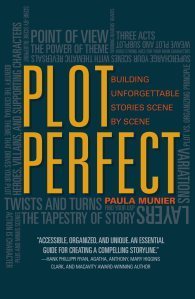Sherry Harris's Blog, page 26
February 27, 2015
Ask the Expert–Paula Munier and Plot Perfect
Welcome Paula Munier to Ask the Expert this Friday. Paula is the author of Plot Perfect: How to Build Unforgettable Stories Scene by Scene.
Think of your favorite story–the one that kept you turning pages late into the night, the one with a plot so compelling, so multilayered, so perfect that you couldn’t put it down. How can you make your own plots–in your novels, short stories, memoirs, or screenplays–just as irresistible?
Plot Perfect provides the answer. This one-of-a-kind plotting primer reveals the secrets of creating a story structure that works–no matter what your genre. It gives you the strategies you need to build a scene-by-scene blueprint that will help elevate your fiction and earn the attention of agents and editors.
By coincidence, this winter, all the Wickeds happened to be working on first drafts at the same time. E-mails flew back and forth. “Using Plot Perfect to help me outline,” Julie wrote. “Using Plot Perfect to figure out a subplot,” Liz said. Here in Key West, my husband Bill, also a writer, and I were passing the book back and forth as we worked on our drafts.
Whoa, I thought. Something is up. So the Wickeds asked Paula here today to answer some questions for us and our readers.
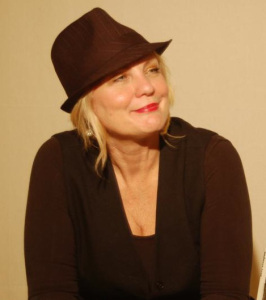 Barb: You’ve been an editor, an agent and an author. Of all the writing elements, why did you feel a book on plot was needed?
Barb: You’ve been an editor, an agent and an author. Of all the writing elements, why did you feel a book on plot was needed?
Paula: As an agent, I’m always looking for good writers telling good stories. I’m not going to rewrite your stories for you if you’re not a good writer, but if you are a good writer I can help you tell a better story.
As an editor, I spent many years helping writers structure their books. Structure is often where good writers go wrong—especially those new to long-form storytelling. Writing a novel is a marathon, not a sprint. And producing a series is one marathon after another. This can be a challenge for new novelists, who may have only written short stories or essays or news articles before trying their hand at the novel. Those writing crime fiction, where plot is so important, really need to master structure before they shop their work.
I represent—and have sold—many debut authors. I love helping novelists get into print!
Barb: Your book is about plot, but you spend a lot of time on the idea of theme in novels. Why is theme so important, and how does understanding your theme support plotting?
Paula: The book is based on my Plot Perfect boot camps. When Writers Digest first asked me to do a plot-related boot camp, I wanted to come up with a different approach to plot. And I chose the theme-related approach to plot, because I’ve seen too many manuscripts that read like video games—all action but no theme. Plot is what happens; theme is what it means. Theme is what your story is really about. I see too many stories that aren’t really about anything—they’re just one action after another. There’s no there there.
For crime fiction, theme is paramount. The themes in this category are big: good vs. evil, kill or be killed, the search for the truth, the nature of justice, society vs. the individual, chaos vs. order, etc. Readers expect crime fiction writers to tackle these big themes—and weave them right into the plot.
Barb: One of the things the Wickeds loved about your book is that while the concepts used in writing a novel can be quite abstract, you make them concrete by providing many, many examples. How long did it take you to write Plot Perfect, how did you find the examples and what criteria did you use to select them?
Paula: I had six months to write the book, but I’d been running the Plot Perfect boot camps for a couple of years already, so I knew the material fairly well. (I also teach at the Algonkian New York Pitch conferences, as well as other venues.)
I use a lot of examples because, as you say, it helps writers extrapolate, and apply what I’m talking about to their own work. I tend to use examples from the writers I love—from Shakespeare and Jane Austen to Dashiell Hammett and Alice Hoffman and Robert B. Parker—as well as the blockbusters that struck a chord with readers—Gone Girl, Eat Pray Love, etc.
Also, I’d be remiss not to acknowledge that my editor at Writers Digest, Rachel Randall, is an even bigger believer in examples then I am—she had me add even more!
Barb: You look at so many books. As an agent, what do you think is the make-or-break? What single element most frequently causes you to take on a book? What single element most frequently causes you to reject it?
Paula: In today’s marketplace, your work really needs a USP: unique selling proposition. That’s marketing speak for being able to set your work apart from the competition. That often boils down to high-concept. Even in cozies, it’s often the cozies with well-defined premises/settings/USPs—the organic farming mystery, the cake decorating mystery, the Pennsylvania Dutch mystery, etc.—that win the contracts.
I always advise writers to read widely in their category—you’d be surprised how many writers don’t! You should pay particular attention to those debut authors who have broken out in the past three years. This is the competition that you’ll need to position your work against.
In terms of clients: I’m looking for a great writer with a story with a strong USP that I think I can sell. If I can’t boil it down to a 50-word pitch, I can’t sell it. That said, I’m a sucker for any writer with a strong voice. I try to stick to the categories I know well and have a soft spot for as a reader: women’s fiction, mainstream fiction, high-concept Sf/fantasy, YA fiction, any kind of crime fiction, as well as nonfiction.
Mostly I pass on projects because 1) the writer’s level of craft is not high enough for prime time yet; 2) the story idea isn’t strong enough; and/or 3) it’s just not my kind of project. Also, I won’t work with any writer who resists revision or refuses to take marketing and promoting her work seriously.
Barb: You’re a writer, too. What are you working on now?
Paula: Thanks for asking! I just finished a new book for Writers Digest called Writing with Quiet Hands: Notes on a Writer’s Craft, in which I talk about what it means to create good stories for today’s changing publishing landscape, and the finer points of craft that can make the difference between getting publishing and not getting published.
I’m also working on a new novel.
Barb: Thanks Paula. Readers, if you have questions or comments for Paula, fire away!
About Paula Munier: Writers are my tribe. I began as a journalist, and over the years I’ve penned countless new stories, articles, essays, collateral, and blogs, as well as authored/co-authored more than a dozen books, most recently Fixing Freddie, 5-Minute Mindfulness, and A Miscellany of Murder. Along the way, I’ve added editor, acquisitions specialist, digital content manager, and publishing executive to my repertoire—the common denominator being my commitment to writers and writing, no matter what my title. From Gannett, Greenspun, and Prima Games to Disney, Quayside, and F+W Media, I’ve fought the good fight for good writing and good writers. And I’ve loved every minute of it.
But now, as an agent, I have the opportunity to support talented writers in the most direct manner possible, helping my clients do good work, land great publishing deals, and build successful writing careers. So if you’re a writer as obsessed with words and stories as I am, and you’re in it for the long haul, consider working with me. My specialties include mystery/thriller, SF/fantasy, romance, YA, memoir, humor, pop culture, health & wellness, cooking, self-help, pop psych, New Age, inspirational, technology, science, and writing.
Filed under: Ask the Expert Tagged: How to write a novel, literary agent, Paula Munier, Plot Perfect

February 26, 2015
How I Learned to Relax About Being a “Cozy” Author and Just Write the Damn Books–Part I
by Barb–sad because we’re leaving Key West in three days (or maybe perplexed is a better word. Why are we returning to the frozen north?)
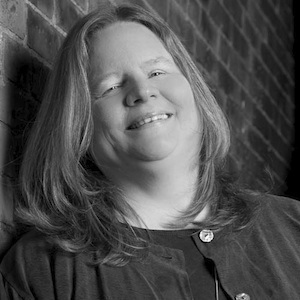 I’ve wanted to write about how I feel about being an author of cozy mysteries for awhile, but it’s always been a complicated and evolving issue. So I’ve decided to split the topic up into three blog posts that I’ll put up during my next several turns here at Wicked Cozys.
I’ve wanted to write about how I feel about being an author of cozy mysteries for awhile, but it’s always been a complicated and evolving issue. So I’ve decided to split the topic up into three blog posts that I’ll put up during my next several turns here at Wicked Cozys.
The Beginning
I didn’t start out to write a cozy. I started out to write a mystery. All my life I had read widely in the mystery field, without really differentiating by sub-genre. I cut my teeth on those amateur sleuths Nancy Drew and Miss Marple, who despite her maiden state, is the grandmother of all of us authors of amateur sleuths. I read Dick Francis and Ross Thomas and John D. MacDonald and Dennis Lehane and Dorothy L. Sayers and Janet Evanovich. Admittedly, it was a simpler time. I found most of my books through recommendations from friends and relatives, as well as friendly independent bookstore clerks and librarians. Megabookstores and online retailers hadn’t yet created such a strong need for subcategory labeling to help you find a book you would like.
I knew I wanted to write a series. I loved the books of P.D. James and Ruth Rendell’s Wexford series. I loved watching characters change over time, and returning to find out what was going on in their lives. I was particularly taken with Rendell’s Kingsmarkham, it’s strong sense of place and how it evolved from a sleepy market village to a sprawling suburb with a highway on-ramp and a diverse population. Even Christie’s St. Mary Mead evolved, sprouting a housing development after the second World War. To me, it was all magic.
 My first mystery, The Death of An Ambitious Woman, had a professional sleuth as its protagonist, a female police chief, but it was also very much a village mystery. Which was one of the many reasons it was so hard to sell, though it was eventually published by Five Star/Cengage.
My first mystery, The Death of An Ambitious Woman, had a professional sleuth as its protagonist, a female police chief, but it was also very much a village mystery. Which was one of the many reasons it was so hard to sell, though it was eventually published by Five Star/Cengage.
We’ve told many times on the blog how our agent, John Talbot, approached Sheila Connolly, who was then President of Sisters in Crime New England, to see if any members had an interest in writing a spec proposal for a cozy mystery series. I was very interested. Because of my love of series, I knew I wanted a multi-book contract, something Five Star didn’t offer. I wrote to Sheila behind the scenes and asked her if she thought I could do it. She pointed out that my first book had a lot of cozy elements. With her encouragement, I called John. We batted some ideas around, and chose “clambake.”
 In that first call, John said, “You know what cozies are, right? Amateur sleuth, small town, ya-da, ya-da.” I’m not sure John actually said “ya-da, ya-da,” but he definitely ya-da, ya-da-ed the definition of a cozy. I assured him that I did and set to work writing the proposal.
In that first call, John said, “You know what cozies are, right? Amateur sleuth, small town, ya-da, ya-da.” I’m not sure John actually said “ya-da, ya-da,” but he definitely ya-da, ya-da-ed the definition of a cozy. I assured him that I did and set to work writing the proposal.
During that period, I read a lot of books that were actually defined as “cozy mysteries.” I read books by our own Sheila Connolly, and by Leslie Meier and Kaitlyn Dunnett/(Kathy Lynn Emerson). I read John Talbot’s most successful cozy author, Cleo Coyle and Kensington’s most successful cozy author, Joanne Fluke. I was inspired by all of them. I also read several frankly terrible cozies. I won’t name any names, but ones I couldn’t finish. Ones that made me dread going to bed because I would have to open them.
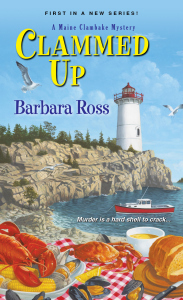 I was undaunted. What area of literature doesn’t have some absolutely awful books in it? None is the answer. And, as I’ve learned over and over, my absolutely awful book is your favorite and vice versa, because the role of personal taste is huge. Besides, though I had tried to keep a professional distance from my proposal, I was falling in love with my characters and my setting. I really wanted to write these stories.
I was undaunted. What area of literature doesn’t have some absolutely awful books in it? None is the answer. And, as I’ve learned over and over, my absolutely awful book is your favorite and vice versa, because the role of personal taste is huge. Besides, though I had tried to keep a professional distance from my proposal, I was falling in love with my characters and my setting. I really wanted to write these stories.
John sold the series to Kensington, and I started writing Clammed Up in earnest. I still hadn’t processed what it meant to be the author of a cozy novel, but now I was paying attention–and starting to panic. It’s interesting that neither of the things I was panicking about affected the story I was writing.
To wit:
If the author is the brand, and the brand is the author, I was in deep trouble. People might describe me in a number of ways, but nobody, including my kids, would ever describe me as cozy. I’m a city girl at heart. I have no pets, I don’t do crafts. I swear like a sailor. I don’t even cook if I can avoid it. Ulp.
The image of cozy mysteries worried me. So often they’re defined as what they are not. You know, it’s a traditional mystery, with an amateur sleuth, but with no sex, gore or swearing. That drove me crazy. Here I am writing 70,000+ words, and the genre is defined by what’s not in there, instead of what is. It bugged the heck out of me. (Or the hell out of me, as I really would say in my real life.)
So the rest of the posts in this series will be a description of my journey with the two personal challenges above, how I evolved, and how I feel about these issues today.
Filed under: Barb's posts Tagged: clammed up, cleo coyle, cozy mysteries, joanne fluke, John Talbot, kaitlyn dunnett, leslie meier, sheila connolly, The Death of an Ambitious Woman

February 25, 2015
Wicked Wednesday — I Shouldn’t Have Worn That Outfit
While getting our photo albums out two weeks ago to look for our worst hairdos we noticed we’d made some questionable fashion choices over the years too. Wickeds were you a trendsetter or fashion follower? Is there a fashion period you wish would come back? And which fashion trends do you hope never darken the doors of the fashion world again?
Liz: Stirrup pants! Anyone remember those? I have no pictures, thankfully, but those were definitely a horrible trend that should never make a comeback. I’ve seen reminders here and there over the years that are threatening to return, but thankfully they’ve never gained traction.
Jessie: Shorts of all kinds! I’m barely 5’3″ and I need absolutely no help in making my legs look any shorter. The only shorts I own are the stretchy sort and I wear them, reluctantly, on my home treadmill. My entire summer wardrobe is made up of dresses which are cooler, more comfortable and look great too.
Edith: I must say, Liz, that I felt very chic in my pink stretch stirrup pants tucked into white go-go boots, with a pink windbreaker over a white sleeveless mock turtleneck shirt. I was in ninth grade, had just outgrown my baby fat, and I thought I looked quite stunning. But who didn’t look stunning at that brief stage between awkward end-of-childhood and… well, never mind. I guess the oversized square plastic glasses frames of the early 80s, and the huge shoulder pads get my vote for questionable fashion. I was not, however, too nonconformist not to wear both myself!
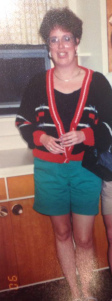 Sherry: When I was in my teens and twenties I was pretty confident of my fashion choices. However, this picture of my thirties points out how horribly wrong I can be. The worse part about the picture is my daughter posted if on Facebook and it keeps getting bumped up to the top when someone new sees it and leaves a comment. I cropped Bob out but really green shorts with a black and red sweater — what was I thinking?
Sherry: When I was in my teens and twenties I was pretty confident of my fashion choices. However, this picture of my thirties points out how horribly wrong I can be. The worse part about the picture is my daughter posted if on Facebook and it keeps getting bumped up to the top when someone new sees it and leaves a comment. I cropped Bob out but really green shorts with a black and red sweater — what was I thinking?
Julie: I’ve been watching Perry Mason movies from the eighties. That was a train wreck of a fashion decade, and I loved EVERY minute of it! Bring back the shoulder pads! Tunics over leggings (real leggings that you can’t see through)–everyone looks good. Button earrings–I’ve still got them. My worse fashion choices are when I look dowdy. Dressing in your 50’s is a fight between being age appropriate and being comfortable. Honestly, the 80’s fashions would help with both!
Readers: Your questionable fashion choices? Or ones that seemed borderline but later were trend forward? (And isn’t it even trend forward to use that phrase?)
Filed under: Group posts Tagged: eighties, shoulder pads, stirrup pants

February 24, 2015
Welcome Shelley Costa
By Liz…still freezing in New England, and making plans for next winter that don’t include snow and ice.
Today, I’m thrilled to welcome Shelley Costa, author of You Cannoli Die Once and Basil  Instinct, to the blog. Shelley is a fabulous writer and awesome person, and I’m so glad she’s taking the time to visit Wicked Cozy Authors today! Here’s Shelley’s bio:
Instinct, to the blog. Shelley is a fabulous writer and awesome person, and I’m so glad she’s taking the time to visit Wicked Cozy Authors today! Here’s Shelley’s bio:
A 2004 Edgar nominee for Best Short Story, Shelley Costa is the author of You Cannoli Die Once and Basil Instinct (Simon and Schuster 2013, 2014). Cannoli was a 2014 Agatha nominee for Best First Novel. Shelley’s mystery stories have appeared in Alfred Hitchcock Mystery Magazine, Blood on Their Hands,The World’s Finest Mystery and Crime Stories, and Crimewave (UK). Shelley teaches creative writing at the Cleveland Institute of Art. Find her at www.shelleycosta.com.
I asked her a few questions about her books and her upcoming projects. Here’s our interview:
For our readers who haven’t met Eve Angelotta yet, tell us about her and the kinds of trouble she’s been finding herself in.
Eve Angelotta is my sleuth who’s the head chef in her family-run, generations-old northern Italian restaurant outside Philly. She’s a former Broadway dancer who had an accident that’s sidelined her, making her turn reluctantly to “la famiglia” for a livelihood. She is a strong, funny, thinks-outside-the-spaghetti-box type of gal.
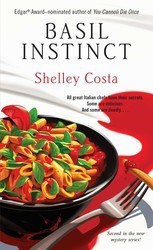 I’m Italian, and I know there’s a lot of fodder there for both humor and murder! Tell us about Eve’s family and where the characters came from.
I’m Italian, and I know there’s a lot of fodder there for both humor and murder! Tell us about Eve’s family and where the characters came from.
Even when murder doesn’t find its way into their kitchen, Eve is up against her elegant but difficult grandmother, Maria Pia, who owns the place and, although she’s technically retired, still makes her big presence and personality felt. Eve’s best friend is her gay cousin (and sous chef) the wonderful Landon Angelotta, and the other cousin employed full-time at the restaurant is the big guy Choo Choo Bacigalupo, a softie who works as maitre d’ — and who actually gets along with Maria Pia! Eve’s nemesis is her second cousin, the flaky, farming Kayla Angelotta who supplies the restaurant produce. All of these characters are truly fictitious, although Mrs. Crawford, the mysterious pianist, is drawn from my eighth grade math and reading teacher (who wore cocktail dresses and wide-brimmed hats to school). Eve herself is probably some fun, crime-solving side of me, since her voice is very strong and clear to me. . . although I can’t quite figure out why she’s funnier than I am.
Your books are hilarious. How easy is it for you to weave humor into murder? Does it come naturally with the characters, or is it something you have to consciously think about?
Thanks! They make me laugh, too. Book One, YOU CANNOLI DIE ONCE, opens with a corpse in the restaurant kitchen who turns out to be Maria Pia’s elderly boyfriend. (Can an arrest be far behind?) And Book Two, BASIL INSTINCT, finds Eve’s new sous chef murdered. . .just as Maria Pia is inducted into a secret, 200 year old all-female (possibly homicidal) cooking society. One has to wonder just how bad the initiation ceremony gets! It’s certaily easier to weave humor into murder when the book is a cozy, right? In cozies the story contains murder, yes, but in some ways the murder is an excuse to live — both writer and reader — for a few hundred pages in an interesting, delicious world with fascinating characters banding together to figure something out. I find it hard to imagine a through-line of humor in other subgenres. Hardboiled PI? No, it’s mean streets and loner-sleuth. Murder just validates the cynicism. There can be a wry narrative voice for sure. But wit or a laugh-out-loud worldview? Not so much. And thrillers take themselves very seriously, which is fine and can be very well done. The murderous situations get ramped way up. Nothing funny in psychopaths or doomsday plots. Me, I’d rather laugh. Bottom line for all of us writing across all the mystery subgenres: it comes down to crime and punishment. Laughs or gore aside, we have that in common. All the rest is just a matter of style or taste.
Talk about setting. Why did you pick Philly?
I grew up in central New Jersey. When that’s where you are, you get carted by school bus or family car either to NYC or Philly. Once or twice I went to New Hope, PA, a charming old town just north of Philly that’s a magnet for antiquing tourists. I wanted to write a place close enough to a major city that it might give me some plot options, and yet interesting and rich in its own right. I grew up in a small town, and I’ve lived in others. I “get” — and like — certain kinds of small towns, the ones with history and civic pride and an array of different kinds of folks going about their lives, so I invented Quaker Hills with a thriving downtown commercial district you get to know in the books.
What’s next for you?
Next up is the first book in a new series, PRACTICAL SINS FOR COLD CLIMATES (Henery Press, January 2016), featuring my thirtysomething sleuth, Valjean Cameron, a NYC editor sent to the Canadian Northwoods to sign a reclusive bestselling author to a book contract. But first she has to find him — a tricky thing to do in her Prada heels. A fish out of water, Val lands in this wilderness community where seasonal residents battle with permanent ones over the development of the lake. Murder ensues. Val has to find her quarry, that bestelling author, prove he isn’t a killer, and get back to the city before she loses her mind. PRACTICAL SINS is a traditional amateur sleuth mystery.
Thanks for visiting, Shelley! Readers, any questions for our guest?
Filed under: Guest posts, Liz's posts Tagged: Basil Instinct, cozy mysteries, Henery Press, Italian food, Philadelphia, Shelley Costa, You Cannoli Die Once

February 23, 2015
Testing…One, Two, Three and Beyond
By Liz, who never wants to see another snowflake again in her lifetime.
In case you missed it on Facebook, Shaggy passed her Canine Good Citizen test last  week. This was a huge milestone for her. She’d been to two obedience classes prior, both of which she completed like a pro, but an “official” test? Nobody likes tests, right? They’re so nerve-wracking.
week. This was a huge milestone for her. She’d been to two obedience classes prior, both of which she completed like a pro, but an “official” test? Nobody likes tests, right? They’re so nerve-wracking.
Anyway, she passed with flying colors, even the one I was most worried about – supervised separation, where she had to stay alone with the trainer for 3 minutes and not fuss. Tough stuff for a spoiled little dog who’s joined to my hip!
 But she did it. And during this process, as I helped her practice for each test, I got to thinking about these tests and how they can apply to humans too. Here are some examples of how the CGC tests have manifested in my life, and how I would fare.
But she did it. And during this process, as I helped her practice for each test, I got to thinking about these tests and how they can apply to humans too. Here are some examples of how the CGC tests have manifested in my life, and how I would fare.
TEST 1: ACCEPTING A FRIENDLY STRANGER
Okay, I have to admit I have an issue with this one. Strangers are not always friendly; therefore they can’t be accepted just because they smile at you. Not to mention, my writer’s brain always thinks the worst about people. I think this is a bad lesson for everyone, including dogs. The last stranger I made eye contact with on the streets of Hartford was an undercover cop with a gun, chasing a bank robber during lunch hour. Come to think of it, he wasn’t that friendly.
Grade: FAIL
TEST 2: SITTING POLITELY FOR PETTING
In human speak, this could read “Sitting politely for politicking.” The equivalent of sitting politely during meetings while posturing, politics and other fun stuff occurs around you. I’m good at “nod and smile.” Most days.
Grade: PASS
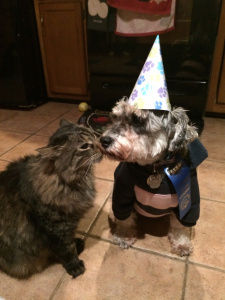
Shaggy getting congratulatory kisses from Tuffy
TEST 3: APPEARANCE AND GROOMING
Looking professional when you’re frozen and the air is so dry you feel shriveled, having to climb mountains of snow and navigate a driveway that’s uphill and covered with ice is tough. However, I’ve managed to hold it together enough to not look like I’ve climbed through the Arctic tundra once I’ve gotten to the office and done some repairs.
Grade: PASS
TEST 4: OUT FOR A WALK (WALKING ON A LOOSE LEAD)
Let’s be clear—I hate winter. I just want to curl up in my blanket and stay inside until this hideous white stuff melts. However, there’s one exception—a daily trip to Starbucks. Certain coworkers and I will brave the most horrendous elements for our daily cup. We’re better than the post office in this regard. I’m thinking specifically of the rainstorm with 40 mile an hour winds that destroyed our umbrellas. Yes, we had a meeting after that. In person. But at least we had coffee.
Grade: PASS
TEST 5: WALKING THROUGH A CROWD
It’s not me, it’s them. If you’re too busy yelling at someone on your cell phone or not watching where you’re going with your baby stroller, it’s not my fault if my big purse nearly takes you out.
Grade: FAIL
 TEST 6: SIT AND DOWN ON COMMAND AND STAYING IN PLACE
TEST 6: SIT AND DOWN ON COMMAND AND STAYING IN PLACE
I command myself every day to sit and stay in front of the computer during my writing time. Doesn’t usually work unless the situation is extremely desperate. (See Test 9)
Grade: FAIL
TEST 7: COMING WHEN CALLED
Depends on who’s calling. In the world of CGC, that matters. So I win.
Grade: PASS
TEST 8: REACTION TO ANOTHER DOG
Depends on the dog. Depends on whether said dog is trying to be alpha, lifting his leg on my cubicle, growling and showing fangs. And then there’s the female dog—and you know what they call those. In both of these cases, I tend to exhibit the same behaviors.
Grade: FAIL
TEST 9: REACTION TO DISTRACTION
I’m on two manuscript deadlines, April 1 and May 1. One manuscript still needs a complete rewrite to incorporate a new theme (more on that later). Still, every time I hunker down to do a big chunk of work, it’s amazing what I let distract me. The ding of a text message, an email teaser, the sound of a puking cat all lead me away from my ultimate goal—to finish the bleeping books on time. (See Test 6)
Grade: FAIL
TEST 10: SUPERVISED SEPARATION
See Test 1. Seeing as extreme supervision is not my strong suit, I don’t think this is a good test for me. And then there’s the whole stranger thing.
Grade: FAIL
As you can see, Shaggy is much more equipped to deal with the world than I am. I guess it’s good I’m a writer and can often hide in my cave.
am. I guess it’s good I’m a writer and can often hide in my cave.
However, I should point out that after class was completed, the blue ribbon was displayed proudly and prizes were given, a dog is still a dog, and will sneak into litter boxes for a snack. In the world of CGC, that’s an extreme fail.
Readers, how would you fare on these tests?
Filed under: Liz's posts Tagged: Canine Good Citizen, Pawsitively Organic Mysteries, schnoodle

February 20, 2015
Wicked New England- Who’s Your Favorite Historical Figure?
Jessie: In NH, shivering and finding mid-winter solace in days gone by.
Recently, as I was poking around the internet doing a little research for my work-in-progress, I ran across this article on something called The Great Snow. It was about a series of unusually brutal storms that occurred in New England back in 1717. I never had heard of this historical tidbit and it got me to thinking about the endurance of the New Englanders of the past. So today Wickeds, I wanted to ask each of you to tell us about your favorite historical New England figure, well-known or more obscure.
Liz: I’ve always been a Nathaniel Hawthorne fan. I’m a Salem, Mass. fanatic, and his ancestry is from Salem, including his great-great grandfather who presided over the Salem Witch Trials. I studied The House of the Seven Gables and The Scarlet Letter in college and always enjoyed his dark style and the depths of his themes.
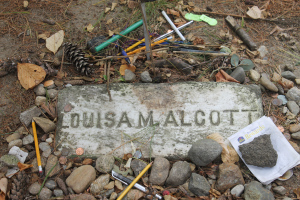 Sherry: Liz, Nathaniel Hawthorne is a favorite of mine too but more from his time spent in Concord. When I first heard we were thinking about this topic I couldn’t decide between Nathaniel, Paul Revere, and Louisa May Alcott. I settled on Louisa. While we lived in Bedford, Massachusetts I took all of our visitors to tour Orchard House in Concord. It’s where Louisa wrote Little Women (originally published as Part One and Part Two). She wrote from a desk her father built for her in her bedroom. If you are ever in the Concord area don’t miss touring the Orchard House. Louisa’s story is fascinating beyond her writing too.
Sherry: Liz, Nathaniel Hawthorne is a favorite of mine too but more from his time spent in Concord. When I first heard we were thinking about this topic I couldn’t decide between Nathaniel, Paul Revere, and Louisa May Alcott. I settled on Louisa. While we lived in Bedford, Massachusetts I took all of our visitors to tour Orchard House in Concord. It’s where Louisa wrote Little Women (originally published as Part One and Part Two). She wrote from a desk her father built for her in her bedroom. If you are ever in the Concord area don’t miss touring the Orchard House. Louisa’s story is fascinating beyond her writing too.
 She’s buried in Sleepy Hollow Cemetery in Concord, MA. On Authors Ridge in her family plot. A peaceful place to visit and you can also visit Nathaniel, Thoreau, and Ralph Waldo Emerson.
She’s buried in Sleepy Hollow Cemetery in Concord, MA. On Authors Ridge in her family plot. A peaceful place to visit and you can also visit Nathaniel, Thoreau, and Ralph Waldo Emerson.
Jessie: One of my favorites is Sarah Orne Jewett. She was raised in South Berwick, Maine, a little over twenty miles from my home. I love the way she was interested in celebrating the lives of everyday people in rural Maine. Her work showed common folk with real affection and she had a knack for creating strong female characters.
Edith: The more I learn about John Greenleaf Whittier for my historical mysteries, the more I 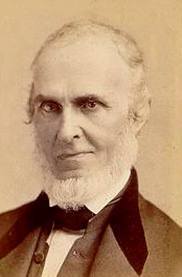 like him. He was an ardent abolitionist and had his life threatened for his views. He had a twinkle in his eye and loved children – he wrote a poem about the tea party he and Celia Thaxter attended that was hosted by a six year old girl. And he was on the building committee for the same Friends Meetinghouse where I go and sit in silent expectant waiting on First Day. He wasn’t above poking fun at authority, he strongly supported the local library, and he had a back exit built into his study in his home (a couple of blocks from my own house) that he could duck out of if he spied an unwelcome visitor coming up the walk. What’s not to like?
like him. He was an ardent abolitionist and had his life threatened for his views. He had a twinkle in his eye and loved children – he wrote a poem about the tea party he and Celia Thaxter attended that was hosted by a six year old girl. And he was on the building committee for the same Friends Meetinghouse where I go and sit in silent expectant waiting on First Day. He wasn’t above poking fun at authority, he strongly supported the local library, and he had a back exit built into his study in his home (a couple of blocks from my own house) that he could duck out of if he spied an unwelcome visitor coming up the walk. What’s not to like?
Barb: Yes, Jessie, and what about the Year Without Summer in 1816? Because of a volcanic eruption in Indonesia throwing dust into the atmosphere, there was a hard frost in every month of the year, including June, July and August and a major snow June 6th after crops had already been planted. Crops failed and what food there was expensive and hard to come by.

Harriet Beecher Stowe
I had a hard time with the assignment. New England offers so many people to choose from. The Pilgrims in their tiny boat. The heroes of the American Revolution. But I finally settled on Harriet Beecher Stowe. It’s apparently apocryphal that when Lincoln met her, he said, “So you’re the little woman who started this great war,” but it is unarguable that Uncle Tom’s Cabin galvanized public opinion. It was the bestselling novel of the 19th century and the second bestselling book, after the Bible. The book was not then, nor is it now, without its detractors, including James Baldwin who was among the first to condemn its stereotypes. On the other hand, Henry Louis Gates, Jr. has more recently been a leader in its re-examination. Any book with that kind of impact will be widely debated over time. What tipped me, finally, into choosing Ms. Stowe, was her demonstration of the power of story to change the conversation and even to move history.
Readers, do you have a favorite figure from history?
Filed under: Wicked New England Tagged: Amesbury Massachusetts, Bedford Masschusetts, Celia Thaxter, Concord Massachusetts, Harriet Beecher Stowe, John Greenleaf Whittier, Little Women, Louisa May Alcott, Nathaniel Hawthorne, Orchard House, Salem Massachusetts, Sarah Orne Jewett, Sleepy Hollow Cemetery, South Berwick Maine, The House of Seven Gables, The Scarlet Letter, Uncle Tom's Cabin

February 19, 2015
It’s Complicated
By Julie, from Snowmagedon, formerly known as Somerville

My current view.
I have written this blog post three times. First time was about plotting. Second time was about character development. Neither of these topics inspired me to finish the post. Because all I can think about is snow. More precisely, the 11.3 more inches Boston needs to break the all time record for snowiest winter. We are currently tied for second snowiest winter, but with a bit of snow due tonight, we’ll move into #2. But I want to be #1.
This should in no way indicate that I am enjoying this snowy winter. I live in the city, and rely on walking and the MBTA to get places. Neither is easy. Commutes take twice as long. Walking down sidewalks means navigating narrow paths etched between buildings and seven foot walls of snow. If someone hasn’t shoveled, you need to walk into the street, and hope the traffic jam doesn’t unclog before you can get back on the sidewalk a block down. Even if I decided to drive places, there’s no where to park. Side streets are clogged with lumps of snow and ice that barely resemble the cars that are buried underneath. Honestly, we have no where to put another foot of snow.
But that foot will make this a record breaking winter. So I want both things–to break the record, and for no more snow. I am comfortable living with this contradiction. Most of my life exists in the complicated zone.
I blame it on being a writer. Part of creating an interesting character is showing her motivations. Some of them are in conflict with one another, and require either a choice to be made, or a compromise with the conflict. Certainly writing a crime novel requires wrestling with complications, highlighting some, misdirecting interest in others.
The younger me did not embrace complicated. I thought everything required making a choice. As I’ve gotten older, I realize that complicated is interesting. That sometimes you can’t choose, or don’t want to. That complicated is preferable to flat.
And so, I root for another foot of snow, even when the idea fills me with despair.
What can I say? I’m complicated.
Filed under: Julie's posts

February 18, 2015
Wicked Wednesday- Mid-Winter Travel Fantasy
Jessie: In NH where the state police have issued an arrest warrant for Punxsutawney Phil
I think of myself as a pretty hardy New Englander. Most winters I simply make soup more frequently and wear wool hand knit hats even when I’m in the house. But lately, this winter has been feeling like just about enough. 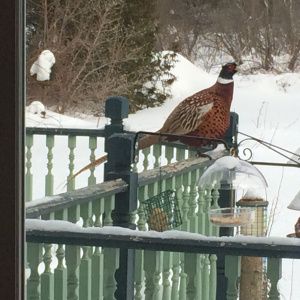 This past Friday things had gotten so bad a pheasant showed up at my bird feeders. As much as I enjoyed the visit I felt unnerved by it as well. Had the woods simply disappeared under all the snow? Or had they been blown away with all the wind? Which got me to thinking about traveling somewhere, anywhere, that is warmer than here.
This past Friday things had gotten so bad a pheasant showed up at my bird feeders. As much as I enjoyed the visit I felt unnerved by it as well. Had the woods simply disappeared under all the snow? Or had they been blown away with all the wind? Which got me to thinking about traveling somewhere, anywhere, that is warmer than here.
So Wickeds, are the rest of you entertaining mid-winter travel fantasies of your own? If you could go anywhere right about now, where would it be?
Liz: Like Jessie, I’ve lived here all my life, so should be used to this. However, winter no longer holds any appeal to me. Short of moving for good, I’ll take winters elsewhere. Which got me thinking about Barb’s winters in Key West. I’d definitely disappear for January, February and March, and Key West has long been on my list to visit (I’ve never made it yet). The pictures she and Bill have been sharing are enticing me and have me thinking about a three-year plan to the same beautiful escape. Barb, would you mind having me for a neighbor for a few months? Regardless, I’d take anywhere warm and beachy right now.
Edith: Warm and beachy. That pretty much sums it up, Liz! Even though I don’t complain about New England winter, mostly, I would love to be somewhere warm and sunny right now. The last time we went to Costa Rica, we swam in the warm Pacific at Manuel Antonio wildlife preserve and hired a guide who showed us all kinds of wildlife we wouldn’t have see otherwise. Retiring to a sunset cocktail and a delicious seafood dinner afterwards was heaven. And guess what – no snow in sight!
wildlife preserve and hired a guide who showed us all kinds of wildlife we wouldn’t have see otherwise. Retiring to a sunset cocktail and a delicious seafood dinner afterwards was heaven. And guess what – no snow in sight!
Sherry: We haven’t had very much snow this winter in the DC area — in fact the five inches on Monday night is pretty much it (of course everything is shut down here because we got — gasp — FIVE inches of snow). But it’s been a very cold, very gray, very windy, winter. And my thoughts are turning more and more frequently to the Caribbean and exotic drinks. 
 The pictures are from a few years ago on St. Thomas.
The pictures are from a few years ago on St. Thomas.
Barb: Liz, we would LOVE it if you were here. C’mon down. You and Lucy Burdette and I could have a regular lunch thing. (Or, even better a cocktails and sunset thing.) Until 1991, I had never taken a warm weather winter vacation. I didn’t even get it. The idea of finding the kids’ bathing suits and shorts exhausted me. But that year, my parents announced they were going to Key West for the month of February. Massachusetts has a public school vacation in February, so I more or less invited ourselves. The minute I got there, and I do mean the minute I got off the plane, I totally got the whole warm weather vacation thing. My parents had a small two-bedroom rental. The kids were on the floor in our room. Until a gecko was spotted, then my daughter Kate was in the bed with me and my husband Bill was on the floor! My parents kept coming, for longer and longer periods of time and eventually bought a house. We visited every year and now that they’re gone, Bill and I carry on the tradition.

The family at Southernmost Point in 2014
Jessie: The Azores. A few years ago NH Public Radio was offering a trip there as part of some sort of winter fundraising event. I have never got the notion of it out of my mind. The average winter temperature is 60 degrees and the summer comes in around 79 degrees. I could live there year round! The islands are known for unique flora and fauna and are an easy plane ride from Boston. What more could you ask for?
Julie: I just dream of not having to wear a dozen layers. And being able to walk without it being an obstacle course. Honestly, being warm and feeling the sun is the dream. Even for an hour or two.
Readers, are you longing for spring too? Where do you think about going to beat the February Doldrums?
Filed under: Wicked Wednesday Tagged: Axores, cold, Costa Rica, Escaping winter, exotic drinks, Key West, lucy burdette, Manuel Antonio, pheasants, snow, Southernmost point, St. Thomas

February 17, 2015
The Detective’s Daughter — Between Friends
 Kim Gray in Baltimore wearing gloves as she types in front of the fire.
Kim Gray in Baltimore wearing gloves as she types in front of the fire.
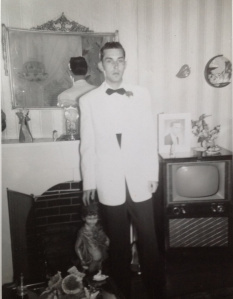 I grew up knowing nothing and everything about love. My parents had a great story about the way they met. It was cute and funny and surely a vehicle for Tom Hanks and Meg Ryan to star in had it been made into a film. Mom was young and working at the front desk of The Lord Baltimore Hotel. Dad had just recently graduated from the police academy. He’d spent a few summers working as a bell hop at The Lord Baltimore and occasionally dropped by to catchup with friends. On one visit a friend persuaded him to pretend he was going to arrest the new girl working at the desk. Dad’s friend liked the new girl and thought this was a good way to meet her. Dad, always game for making someone feel uncomfortable, proceeded to play along. Things didn’t go as planned for the friend, but went rather well for Dad. Several months later my parents were married.
I grew up knowing nothing and everything about love. My parents had a great story about the way they met. It was cute and funny and surely a vehicle for Tom Hanks and Meg Ryan to star in had it been made into a film. Mom was young and working at the front desk of The Lord Baltimore Hotel. Dad had just recently graduated from the police academy. He’d spent a few summers working as a bell hop at The Lord Baltimore and occasionally dropped by to catchup with friends. On one visit a friend persuaded him to pretend he was going to arrest the new girl working at the desk. Dad’s friend liked the new girl and thought this was a good way to meet her. Dad, always game for making someone feel uncomfortable, proceeded to play along. Things didn’t go as planned for the friend, but went rather well for Dad. Several months later my parents were married.
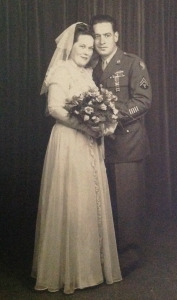 I loved when Mom told this story. Dad never said anything, he only nodded or agreed with Mom’s version. Neither my mom or dad were big talkers. In fact they seemed to ration their words as if they only had a certain amount to spare each day. While my parents spent the majority of their time in our second floor apartment in silence, my grandparents were bickering on the first floor. I should say Nana was bickering, Pop-Pop was only muttering under his breath. But he did exactly what she said. We all did. As a child, I could never understand why Nana seemed angry with Pop-Pop. To this day, no one can convince me he wasn’t the most wonderful man to walk this Earth. How could she not see this?
I loved when Mom told this story. Dad never said anything, he only nodded or agreed with Mom’s version. Neither my mom or dad were big talkers. In fact they seemed to ration their words as if they only had a certain amount to spare each day. While my parents spent the majority of their time in our second floor apartment in silence, my grandparents were bickering on the first floor. I should say Nana was bickering, Pop-Pop was only muttering under his breath. But he did exactly what she said. We all did. As a child, I could never understand why Nana seemed angry with Pop-Pop. To this day, no one can convince me he wasn’t the most wonderful man to walk this Earth. How could she not see this?
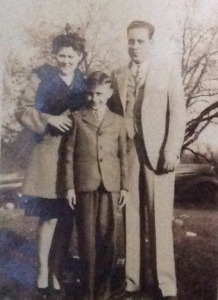 Nana and Pop-Pop, or Fan and Lou as they were called, had been friends since their teenage years. They were so close that many believed they would one day marry. Before Lou could propose, Fan met a young widower and married him after a short courtship. Within the year Lou also married. Lou’s marriage ended in divorce and Fan’s happiness was also short lived. After my dad was born, his father died eighteen months later. Fan was widowed at the age of thirty four. She and Lou had remained part of the same crowd. Lou was the best friend of Fan’s brother. When Dad was nearly eight, Fan and Lou finally married.
Nana and Pop-Pop, or Fan and Lou as they were called, had been friends since their teenage years. They were so close that many believed they would one day marry. Before Lou could propose, Fan met a young widower and married him after a short courtship. Within the year Lou also married. Lou’s marriage ended in divorce and Fan’s happiness was also short lived. After my dad was born, his father died eighteen months later. Fan was widowed at the age of thirty four. She and Lou had remained part of the same crowd. Lou was the best friend of Fan’s brother. When Dad was nearly eight, Fan and Lou finally married.
Nana and Pop-Pop did everything together. They went out every Friday night to Miss Leona’s bar to listen to music and play games. On Sunday it was over to Bissert’s for dinner. All the while my parents sat upstairs, each in their own world. I never heard a cross word pass between them, but I rarely heard any words. They were friend with other police couples, but rarely socialized. As an adult I realize it wasn’t because they were naturally shy, it was because they had nothing to say to one another.
I was in grade school when my Pop-Pop died from cancer. Nana was sitting at her kitchen table looking through the paper. “I’ve lost my best friend,” she said. “Me, too.” I agreed. My parents could never seem to live up to their story. It seemed impossible to me that these two beautiful people were not destined to have a happy ever after. Though Nana and Pop-Pop’s story was not one of a great romance, their solid friendship stood firm.
Years later, as Nana suffered dementia, she would tell me about her visits with Pop-Pop. “You just missed him,” she would tell me and I would look around convinced she was right and he had been here only moments ago. They both passed away in the month of February, he on the twelfth and she on the fourteenth, nearly twenty years apart.
As we celebrate love this month we should also celebrate friendship. Crushes and romances may come and go, but it is that sturdy foundation of friendship that keeps us stable and moving forward to our next great love.
Filed under: The Detective's Daughter Tagged: Lord Baltimore Hotel, Meg Ryan, The Detective's Daughter, Tom Hanks

February 16, 2015
Best First Agatha Nominees on Writing
I’m humbled and thrilled to be one of the nominees for an Agatha Award for Best First novel this year. I asked my fellow nominees Annette Dashofy, Terrie Farley Moran, Susan O’Brien, and Tracy Weber to join me to talk about getting published. Is the book you are nominated for the first book you wrote? And from the time you decided to write a novel how long did it take you to get published?
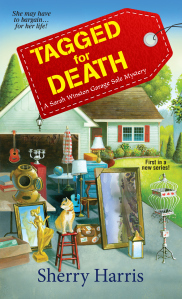 Sherry: My journey was a long one. I joke that I started writing on stone tablets with a chisel. In some ways I’ve always written stories whether they were for my high school yearbook, my job in marketing for a financial planning company or writing humorous Christmas letters. What pushed me to write a novel was a short story contest advertised in the newspaper when we lived in Dayton, Ohio. I quickly realized the story was too big and ended up writing two and half books that still sit in the proverbial drawer.
Sherry: My journey was a long one. I joke that I started writing on stone tablets with a chisel. In some ways I’ve always written stories whether they were for my high school yearbook, my job in marketing for a financial planning company or writing humorous Christmas letters. What pushed me to write a novel was a short story contest advertised in the newspaper when we lived in Dayton, Ohio. I quickly realized the story was too big and ended up writing two and half books that still sit in the proverbial drawer.
I learned a lot by writing those books, taking classes, attending conferences, reading books about writing, and editing books for other authors. So when the opportunity to write a series with a garage sale theme came to me via a New York City editor, agent, and finally through friend Barbara Ross, I was in the words of Barbara, “ready”. From writing the proposal for the Sarah Winston Garage Sale series to contract was a month and a half. From contract to the publication of Tagged for Death was a year and ten months.
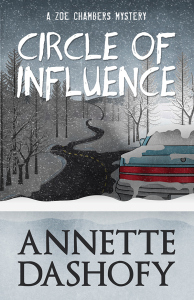 Annette Dashofy: My first writing implement was a crayon, so that should give you an idea of how long I’ve been doing this. In high school I wrote “novels” longhand in spiral-bound notebooks. Now it would be called fan fiction. Back then I simply created a character that was me and stuck her into my favorite TV shows. My “fans” read my stories in study hall. They’d pass them around and eventually the notebook came back to me with orders to keep writing.
Annette Dashofy: My first writing implement was a crayon, so that should give you an idea of how long I’ve been doing this. In high school I wrote “novels” longhand in spiral-bound notebooks. Now it would be called fan fiction. Back then I simply created a character that was me and stuck her into my favorite TV shows. My “fans” read my stories in study hall. They’d pass them around and eventually the notebook came back to me with orders to keep writing.
I didn’t get serious about publishing my fiction until decades later when the bug bit me in 2004. I wrote one novel that no one will ever see again. Trust me. It was bad. A second novel snagged me two agents, but no publisher. I kept writing. Circle of Influence (Zoe Chambers Mysteries) was the fourth manuscript I wrote, but the first to be published—finally—in 2014.
 Terrie Farley Moran: I have always known that I would be a mystery writer someday. Lo and behold “someday” finally showed up in early 2003 when I started writing Driven to Death. It took me a few trial-and-error years to finish the first draft. In 2006 at the exact moment I started the second draft, my Sisters in Crime chapter put out a call for submissions for short stories for a chapter anthology. I wrote a story called “Strike Zone” and two things happened. First, I discovered that I absolutely loved writing short mystery fiction and second, my story was accepted and the anthology Murder New York Style was released in 2007.
Terrie Farley Moran: I have always known that I would be a mystery writer someday. Lo and behold “someday” finally showed up in early 2003 when I started writing Driven to Death. It took me a few trial-and-error years to finish the first draft. In 2006 at the exact moment I started the second draft, my Sisters in Crime chapter put out a call for submissions for short stories for a chapter anthology. I wrote a story called “Strike Zone” and two things happened. First, I discovered that I absolutely loved writing short mystery fiction and second, my story was accepted and the anthology Murder New York Style was released in 2007.
I continued writing short stories and was lucky enough to have them published in various venues including Ellery Queen Mystery Magazine, Alfred Hitchcock Mystery Magazine and an MWA anthology. All the while I edited and polished Driven to Death. Finally, in February 2012 I met a fabulous literary agent, Kim Lionetti of Bookends LLC. When she turned down Driven to Death, Kim said she liked my voice and style and asked if I would write something else, which led to Well Read, Then Dead the first in the Read Em and Eat Mystery series and a 3 book contract with Berkley Prime Crime. Typical writer’s path. Up, down and all around.
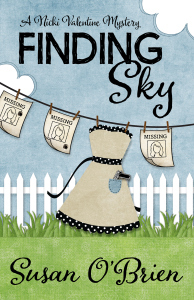 Susan O’Brien: In the middle of writing Finding Sky, the first in the Nicki Valentine mystery series, I was hired to write Child Abduction and Kidnapping, an educational book for young adults. The pay was relatively low (with no royalties), but I’m passionate about children’s safety, so it just felt meant to be. Part of my earnings from Finding Sky are donated to missing children’s organizations. Also, I got quite sick while writing Finding Sky and wrote a spiritual/medical memoir, which I can’t wait to edit when I “have time” someday!
Susan O’Brien: In the middle of writing Finding Sky, the first in the Nicki Valentine mystery series, I was hired to write Child Abduction and Kidnapping, an educational book for young adults. The pay was relatively low (with no royalties), but I’m passionate about children’s safety, so it just felt meant to be. Part of my earnings from Finding Sky are donated to missing children’s organizations. Also, I got quite sick while writing Finding Sky and wrote a spiritual/medical memoir, which I can’t wait to edit when I “have time” someday!
It’s funny to think about the time from deciding to write a novel to pursuing publication. I’ve wanted to be an author since childhood, so in a way, it took decades! Finding Sky was written over many years while I was busy raising children and freelance writing. Once I started querying, it took a little more than a year to have a signed contract. I chronicled the experience on Twitter in hopes of connecting with other writers. My first tweet was about sending my first query letter! I’m thrilled and grateful to be on this journey with each of you and the entire, incredible writing community!
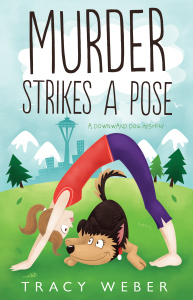 Tracy Weber: I am so incredibly lucky. Yes, Murder Strikes a Pose is my first novel and the first of the Downward Dog mystery series. In fact, it’s my first attempt at writing fiction except for a short story I wrote in college at age 20 and a three-page very bad flash fiction piece I wrote a few years ago.
Tracy Weber: I am so incredibly lucky. Yes, Murder Strikes a Pose is my first novel and the first of the Downward Dog mystery series. In fact, it’s my first attempt at writing fiction except for a short story I wrote in college at age 20 and a three-page very bad flash fiction piece I wrote a few years ago.
I thought about writing Murder Strikes a Pose for almost two years before I actually sat down and put fingers to keyboard. Once I started, the words poured out of me and I wrote the first draft in three weeks! (Subsequent drafts took significantly longer.) ;-) I refined the work for about a year with the help friends and a wonderful freelance editor named Marta Tanrikulu. When I started submitting, things went quickly. I signed with my agent, Margaret Bail, within a few weeks and she sold the first three books in the series a few weeks after that. Murder Strikes a Pose was on bookshelves nine months later.
So, from typing “Chapter 1” to publication was about two and a half years. Only one year of that was actually writing. ;-)
Sherry: Thanks so much for taking time out of your busy schedules to share a bit about your writing journey! I really enjoyed each of your stories.
Filed under: Sherry's posts Tagged: Agatha Award Best First Novel, Annette Dashofy, Circle of Influence, Downward Dog mystery series, Finding Sky, Murder Strikes a Pose, Nicki Valentine Mysteries, Read Em and Eat Mysteries, Sarah Winston Garage Sale Mysteries, Sherry Harris, Susan O'Brien, Tagged for Death, Terrie Farley Moran, Tracy Weber, Well Read Then Dead, Zoe Chambers mystery


